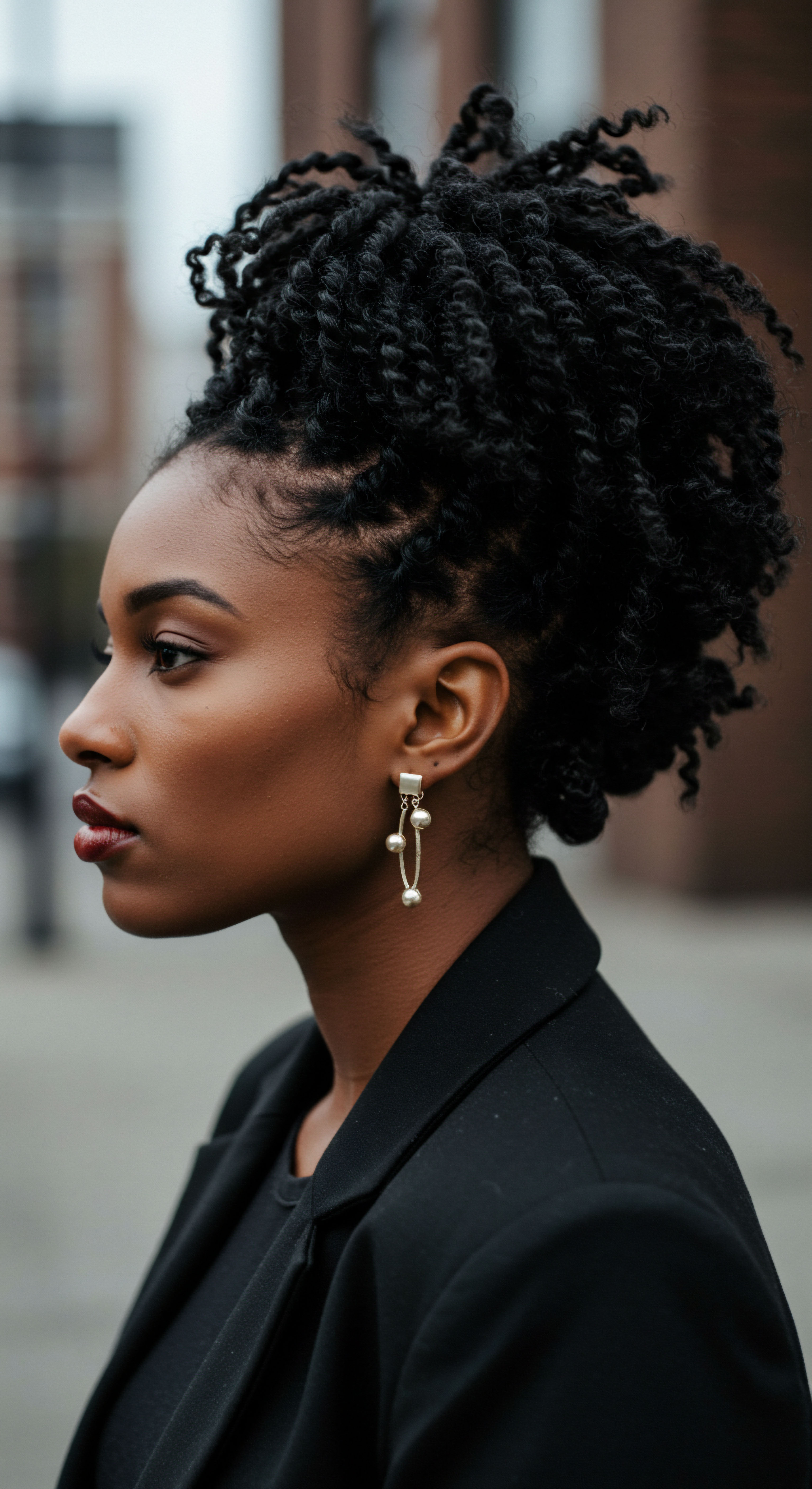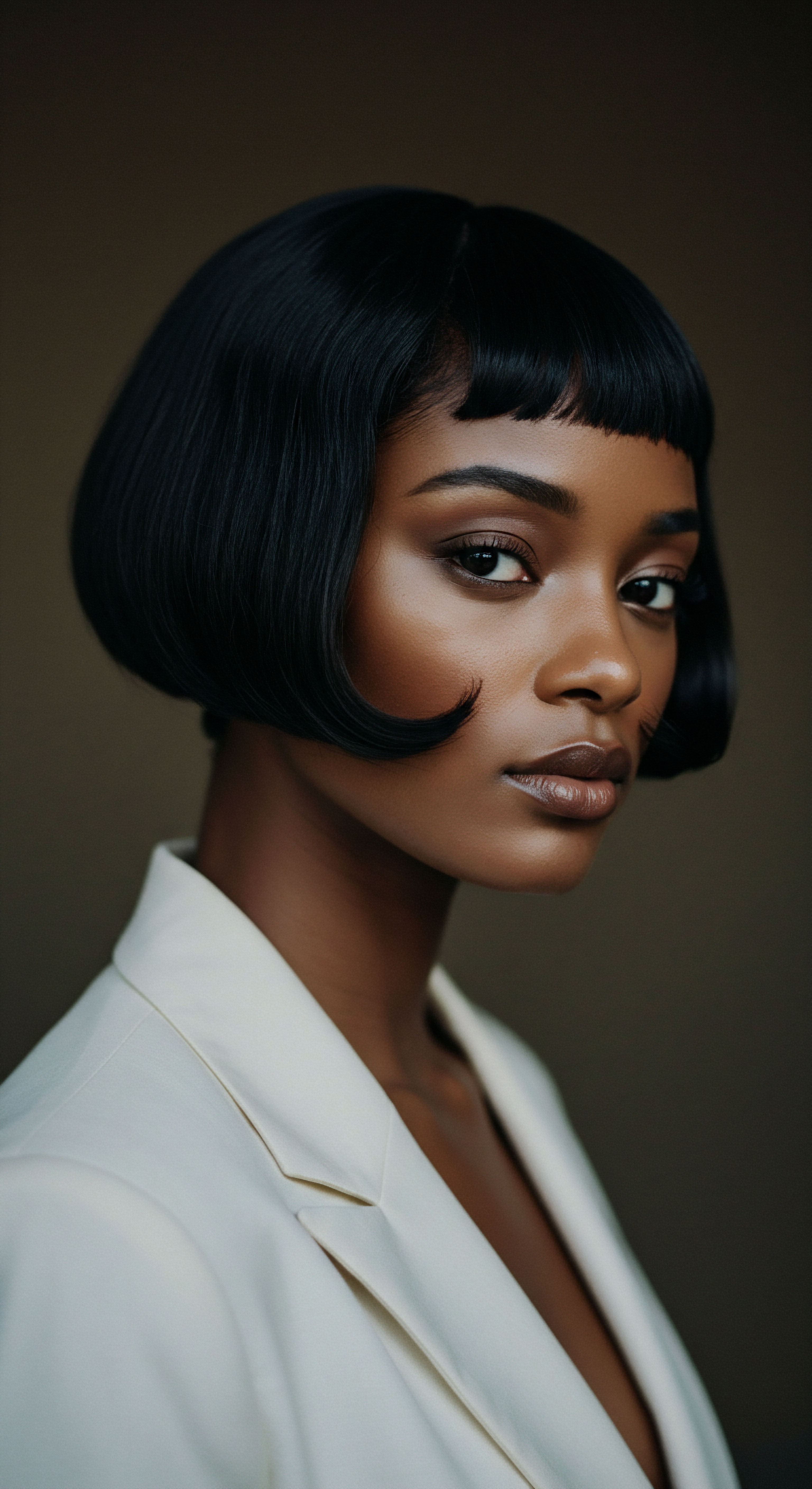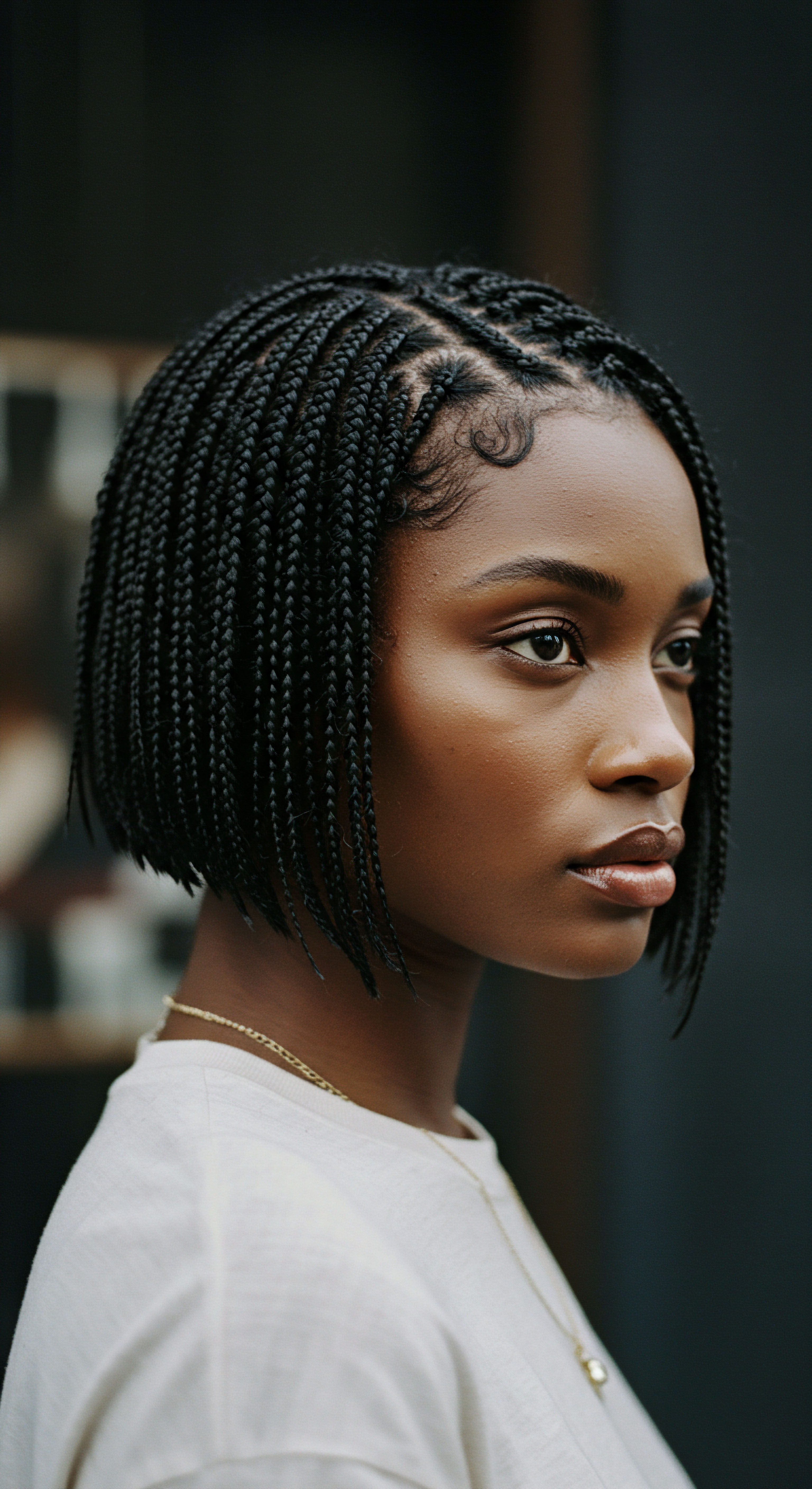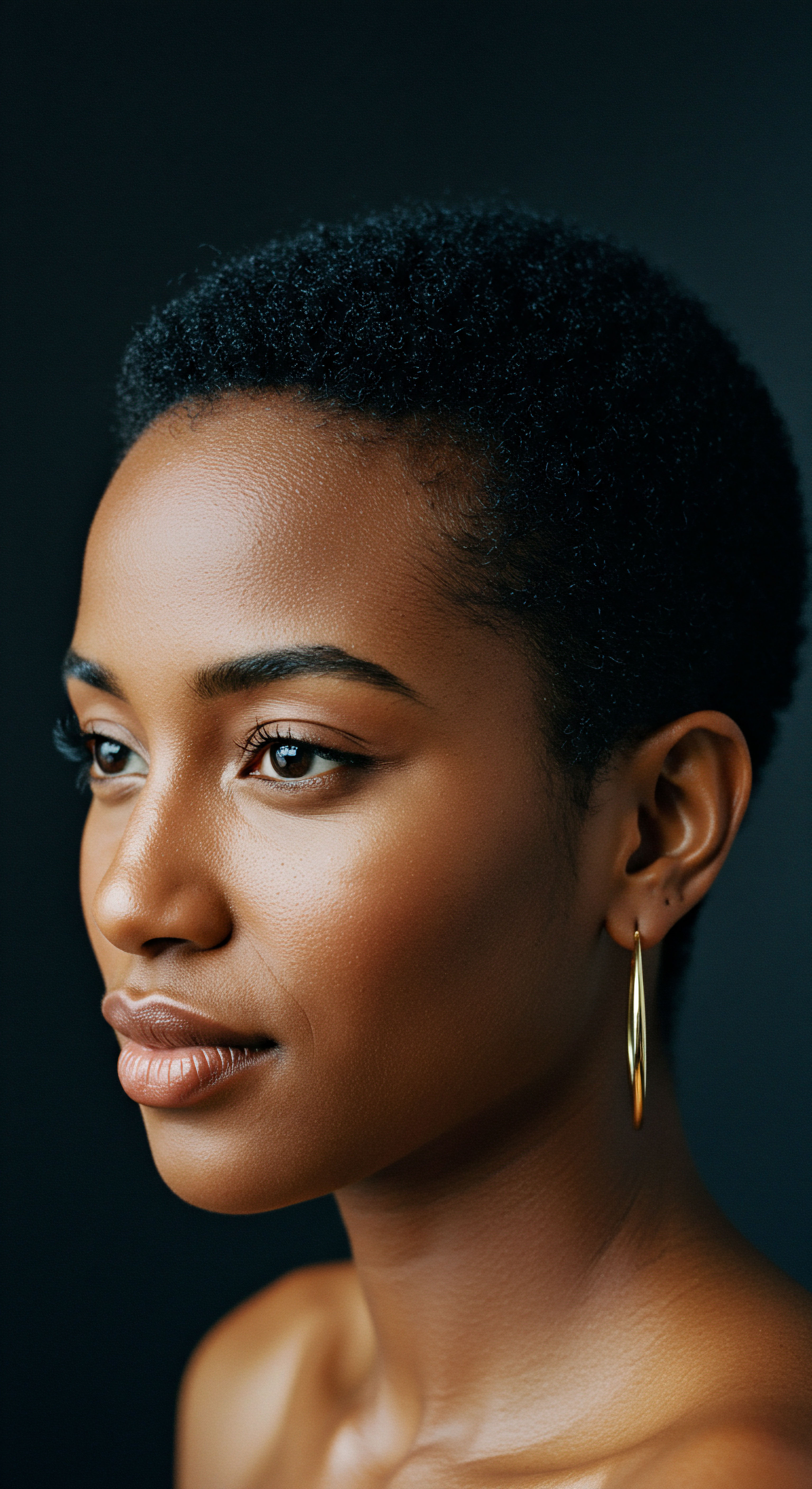
Roots
A quiet contemplation often begins with the simplest of observations ❉ the delicate frame of hair around our faces, the very edge where skin meets strand, shaping our visage. This boundary, the hairline, holds more than aesthetic weight; it represents a story, a connection to vitality, and sometimes, a quiet concern. To truly comprehend our present efforts in preserving hairline fullness, we might turn our gaze to the customs of generations past, seeking not just techniques, but the underlying philosophies that guided ancient hands.
Consider the deep reverence for hair across various ancient civilizations. For many, hair was a symbol of strength, status, and spiritual connection. This profound respect naturally extended to its care, shaping practices that, while seemingly rudimentary by today’s scientific standards, often held a quiet wisdom rooted in observation and generational knowledge. The care was not merely cosmetic; it was often an act of mindful attention, a recognition of hair as an extension of the self.
Ancient hair care practices, often rooted in cultural reverence, offer foundational insights into maintaining scalp health and hair integrity.

Ancient Understanding of Hair Anatomy
Long before microscopes unveiled the intricate structure of a hair follicle, our ancestors possessed an intuitive grasp of hair’s fragility and its need for sustenance. They understood that healthy hair sprang from a healthy scalp. This comprehension, though unarticulated in modern biological terms, led to practices that prioritized scalp conditioning and protection. The very act of cleansing and anointing the scalp was an acknowledgement of its role as the origin point for each strand.
- Scalp Stimulation ❉ Many ancient cultures practiced regular scalp massage, often with various oils, to promote what they likely perceived as circulation or ‘flow’ to the hair roots.
- Natural Emollients ❉ Oils derived from plants, such as olive, coconut, and castor, were widely used, not just for shine, but for their perceived conditioning and protective qualities.
- Gentle Cleansing ❉ Early cleansing agents were often milder than modern surfactants, relying on natural saponins or clays, which likely preserved the scalp’s delicate balance.

Cultural Traditions and Hair Preservation
Across continents, the commitment to hair preservation was evident in diverse cultural traditions. In ancient Egypt, elaborate wigs and extensions, crafted from human hair and plant fibers, were not just fashion statements but also served a protective function against the harsh desert sun and elements. These coverings minimized exposure to environmental stressors, a concept we still value today in modern protective styling. The preparation of these hairpieces involved careful cleaning and oiling, suggesting a long-standing knowledge of material preservation.
Similarly, in various African societies, complex braiding and coiling patterns served not only as markers of identity and status but also as practical methods for safeguarding the hair. These styles reduced daily manipulation, minimized breakage, and allowed for the regular application of nourishing balms and oils directly to the scalp. The continuity of such practices across generations speaks to their perceived efficacy in maintaining hair strength and length, particularly at vulnerable areas like the hairline.
Consider the extensive use of oils in traditional Indian Ayurvedic practices. For centuries, practitioners have prescribed specific herbal oils, like bhringraj and brahmi, massaged into the scalp, believing them to strengthen hair roots and avert premature graying or thinning. While the scientific mechanisms are now being investigated, the historical emphasis on consistent, gentle application directly to the scalp region aligns with modern trichological recommendations for maintaining hairline integrity. The systematic application of these botanical concoctions, often warmed, created an environment supportive of scalp vitality.

Ritual
Stepping from the quiet contemplation of origins, we find ourselves amidst the rhythms of daily and periodic practices. The very word “ritual” suggests a purposeful repetition, an act imbued with meaning beyond its immediate physical execution. When we consider the care of our hair, particularly the often-tender hairline, these historical rhythms offer a gentle guide, reflecting a wisdom that sought to sustain, rather than simply treat. It is in these deliberate movements, these moments of attentiveness, that the past truly informs our present pursuit of hairline density.
The notion of consistency, so paramount in modern hair wellness, finds its echoes in ancient hair care rituals. Whether it was the weekly anointing of hair with specific oils or the daily detangling with natural combs, these were not sporadic efforts but ingrained habits. This sustained attention, applied over time, allowed for gradual improvements and preventative measures, particularly important for the delicate hairs along the facial perimeter.
Consistent, purposeful hair care practices, passed down through generations, reveal a deep understanding of ongoing maintenance for hairline preservation.

The Art of Gentle Manipulation
Many historical practices highlight an inherent understanding of hair’s delicate nature, especially when wet or during styling. The use of wide-toothed combs crafted from wood or bone, the slow and methodical detangling, and the avoidance of harsh pulling are recurring themes. This contrasts sharply with some modern habits that involve aggressive brushing or tight styling, which can place undue tension on the hairline, leading to thinning over time.
- Finger Detangling ❉ Before the advent of modern tools, fingers were often the primary detangling instrument, allowing for a more sensitive approach to knots and tangles, minimizing breakage at the root.
- Loose Styling ❉ While elaborate, many traditional styles were designed to distribute tension evenly or protect fragile areas, avoiding constant, localized pulling on the hairline.
- Hairline Protection ❉ Specific attention was often paid to the edges, using softer materials for ties or ensuring styles did not pull too tightly on this sensitive area.

Nighttime Sanctuary for Strands
One of the most striking parallels between historical wisdom and modern hairline preservation lies in the care given to hair during sleep. Across various cultures, there existed a tradition of protecting hair at night. This wasn’t merely about maintaining a hairstyle; it was about safeguarding the hair from friction, tangles, and moisture loss that could occur during restless slumber.
Consider the widespread use of head coverings in various traditional societies. From silk scarves in parts of Africa to cotton turbans in ancient Persia, these coverings created a protective barrier. They shielded the hair from abrasive bedding materials, which could cause friction and breakage, particularly along the hairline where strands are often finer and more vulnerable. This simple yet profound practice reduced mechanical stress on the hair follicles, allowing them to rest and recover.
Modern approaches to preserving hairline density often emphasize similar principles. The recommendation of silk or satin pillowcases, or the wearing of silk or satin bonnets, directly mirrors these ancient practices. These materials minimize friction, reduce moisture absorption from the hair, and help maintain the integrity of delicate hairline strands. This gentle buffering against environmental stressors during the night is a direct lineage from historical wisdom, adapted for contemporary life.
| Cultural Context Various African Traditions |
| Method Silk or cotton head wraps |
| Underlying Principle Reduced friction, moisture retention, style preservation |
| Cultural Context Ancient Persia |
| Method Turbans or head coverings |
| Underlying Principle Protection from dust, heat, and mechanical damage |
| Cultural Context Indigenous American Practices |
| Method Braiding before sleep |
| Underlying Principle Prevented tangling, minimized breakage during rest |
| Cultural Context These practices universally sought to shield hair from nocturnal damage. |

The Wisdom of Natural Ingredients
The reliance on natural ingredients, often locally sourced and deeply understood, forms another powerful bridge between past and present. Ancient peoples utilized a vast pharmacopoeia of plants, minerals, and animal products for their hair. These were not chemically altered concoctions but often raw, unprocessed elements applied directly to the scalp and hair.
For instance, the use of aloe vera, widely recognized for its soothing and moisturizing properties, dates back thousands of years in various cultures, from ancient Egypt to traditional Indian medicine. Its application to the scalp would have provided hydration and calmed irritation, creating a healthier environment for hair growth. Similarly, rosemary, valued for its stimulating properties in European folk medicine, is now a subject of modern research for its potential to support hair growth.
A study published in the journal Skinmed compared the efficacy of rosemary oil to minoxidil in treating androgenetic alopecia, finding comparable results in hair count increase after six months, with less scalp itching associated with the rosemary oil group. This example illustrates how traditional observations, once dismissed as anecdotal, are now gaining scientific validation, offering a compelling argument for revisiting the botanical remedies of our ancestors.
This connection underscores that the quest for hair wellness is not a new phenomenon. Our forebears, through trial, error, and keen observation, discovered powerful allies in the plant kingdom, laying a foundation for today’s ingredient-conscious hair care.

Relay
How do we truly grasp the deeper, often unseen currents that connect ancient hair practices to the sophisticated science of hairline preservation today? This pursuit beckons us beyond simple techniques, inviting us into a multi-dimensional consideration where biology, cultural memory, and modern innovation converge. It is here, in this intricate interplay, that the full resonance of historical wisdom truly begins to sing, offering profound insights into the delicate balance required for sustained hairline density.
The hairline, a visible indicator of hair health, often bears the brunt of external stressors and internal imbalances. Historical practices, though lacking modern scientific terminology, implicitly addressed these stressors through a combination of protective measures, gentle handling, and consistent nourishment. Their wisdom, passed down through generations, often focused on prevention and long-term vitality, rather than reactive treatment.
The enduring principles of protection, gentle care, and consistent nourishment from historical hair practices directly inform contemporary strategies for hairline preservation.

Understanding Scalp Microcirculation
Many ancient hair care rituals, particularly those involving scalp massage and the application of warming oils, appear to have intuitively supported scalp microcirculation. While they did not speak of capillaries or blood flow, the consistent, gentle stimulation of the scalp would have promoted nutrient delivery to the hair follicles and waste removal. Modern trichology places significant emphasis on robust blood supply to the scalp as a cornerstone of healthy hair growth, particularly for the active follicles at the hairline.
For instance, the traditional practice of “oiling” in various cultures, where warm oils are massaged into the scalp, may have directly contributed to better scalp health. The warmth and mechanical action could increase local blood flow, ensuring that the dermal papilla, the hair’s growth center, receives ample oxygen and nutrients. A diminished microcirculation is a known factor in hair thinning and recession, making this historical emphasis on scalp vitality particularly relevant.

The Biophysics of Hair Tension and Protection
The elaborate protective styles prevalent in many textured hair cultures, such as braids, twists, and locs, demonstrate an early understanding of hair biophysics. These styles, when executed properly, minimize the daily mechanical stress on individual strands and, crucially, on the hairline. Traction alopecia, a common form of hair loss affecting the hairline, results from chronic pulling on the hair follicles. Ancient protective styles, by gathering hair into stable, distributed configurations, inherently reduced this localized tension.
The selection of natural fibers for head coverings, as discussed earlier, also speaks to a nuanced understanding of material science. Silk and satin, with their smooth surfaces, create less friction against the hair shaft compared to coarser materials like cotton. This reduction in friction is vital for preserving the delicate cuticle layer of the hair, preventing breakage, and maintaining moisture, all of which contribute to the overall health and density of the hairline.

The Interplay of Moisture and Elasticity
Historical practices often incorporated ingredients and methods that prioritized moisture retention. The consistent application of oils and butters, and the use of protective styles that sealed in moisture, helped maintain the hair’s elasticity. Hair that is well-hydrated is more pliable and less prone to breakage, especially at the hairline, which is often exposed and subject to environmental dryness.
Dry, brittle hair is more susceptible to snapping under tension, leading to perceived thinning. The deep conditioning treatments, often involving fermented rice water or herbal infusions in Asian traditions, exemplify this ancient understanding of hydration’s role in hair resilience.

Sociocultural Influences on Hairline Perception
Beyond the biological and physical aspects, historical perspectives also shed light on the sociocultural factors that shaped perceptions of hairline density. In many societies, a full, well-defined hairline was a mark of youth, vitality, and beauty. This cultural value placed an inherent emphasis on practices that would preserve this aesthetic, creating a communal knowledge base around preventative care.
The communal nature of hair care in many historical contexts, where women often braided each other’s hair or shared recipes for herbal rinses, created a system of shared wisdom and accountability. This collective reinforcement of healthy practices contributed to the longevity and efficacy of these traditions. In modern times, the rise of online communities dedicated to textured hair care mirrors this communal sharing, offering support and knowledge exchange that can aid in hairline preservation efforts.
Ultimately, the relay of historical hair care wisdom to modern approaches for preserving hairline density is not a linear progression but a circular conversation. The past provides the principles, the present offers the scientific validation and refinement. By honoring the gentle, consistent, and protective philosophies of our ancestors, we gain a deeper appreciation for the nuanced care our hairlines deserve, ensuring their vibrancy for generations to come.

Reflection
As we step back from this exploration, a quiet truth settles ❉ the preservation of hairline density is not a novel concern, but a timeless pursuit. The hands that once kneaded ancient oils into scalps, or meticulously crafted protective braids, were guided by an intuitive wisdom that resonates with our deepest scientific understandings today. It reminds us that sometimes, the most sophisticated solutions are found not in complex innovations, but in the gentle echoes of traditions long held. Perhaps, in our quest for radiant strands, we are simply remembering what our ancestors already knew.

References
- Panahi, Yunes, et al. “Rosemary oil versus minoxidil 2% for the treatment of androgenetic alopecia ❉ a randomized comparative trial.” Skinmed 13.1 (2015) ❉ 15-21.
- Robbins, Clarence R. Chemical and Physical Behavior of Human Hair. Springer, 2012.
- Bouffard, Suzanne. Hair ❉ A Cultural History. University of California Press, 2016.
- Katz, Esther, and Mary T. L. Caine. The Anthropology of Hair. Berg, 2005.
- Gavazzoni, Cristina. Hair and Scalp Treatments ❉ A Practical Guide. Springer, 2017.
- Burg, Dieter, and T. E. King. Hair Biology and Hair Disorders. Springer, 2014.
- Trueb, Ralph M. Hair ❉ Its Structure and Functions. Springer, 2008.
- Dawber, Rodney, and H. J. H. Van Der Ploeg. Diseases of the Hair and Scalp. Blackwell Science, 1997.